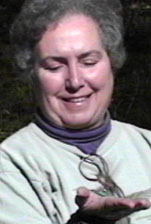
Nancy L. Newfield has been
watching hummingbirds at her Louisiana home and lots of other places since 1975.
Nancy lost her amateur status years ago, and now writes and lectures on hummers.
She is co-author of Hummingbird Gardens, reviewed
elsewhere on this site. Nancy is also a licensed hummingbird bander and a recognized
authority on hummingbird distribution, behavior, and taxonomy. |
May 1998
A Home Is Not a House
The word "home" conjures up many images. To many people, "home"
means the structure in which they live or the one in which they grew up - a house
or an apartment. To others "home" is the spirit of neighborhood, city,
or country of origin.
For birds, hummingbirds, "home" can have several meanings as well. The
flower-filled territory that a male holds by bluff and bluster is home - for awhile.
As one type of flower passes its peak of flowering, the territory may no longer be
productive enough to support the bird's "at home" activities - fighting,
displaying, mating, etc. When this happens, the resident must seek another place
to live.
The focal point of the female hummer's territory is her nest - an actual structure,
a dwelling place, so to speak. The nest and its surrounding area are "home"
- for awhile. In choosing a "home" site, the female looks for safety and
security in the area, proximity to food sources, and proximity to potential mates.
These hummer "homes" are permanent - for awhile. The resident may hold
the territory for some weeks or months. After the breeding season, the "home"
may be vacated as the territory-holder wanders or migrates away.
Of course, hummers hold territories, "homes" if you will, during their
various peregrinations and winter residencies too. Sometimes, the "home"
is defended for only a few minutes, then ceded to another bird as the original territory-holder
moves on. Other times, the territory is held for months. It is "home" for
awhile.
The greatest threat to hummer "home security" is habitat alteration. Each
species has a specific set of requirements for the habitat in which it makes its
home. Habitats change naturally through various successions. And, any number of natural
disasters - flood, fire, hurricane, tornado - can wipe out hundreds of acres of hummer
territories in an instant. However, alteration of the natural habitats to accommodate
human needs and desires surely has a greater impact than anything Mother Nature can
dish out!
Some species are better able to withstand the onslaught than others. Anna's Hummingbirds
on the Pacific coast seem to make a good living rapidly sprawling suburbs. But the
Ruby-throated Hummingbirds of eastern North America usually prefer to nest farther
from human activities. Loss of woodlands has no doubt already had a significant effect
on populations in some regions.
The clearing of tropical forests in Central America may actually benefit a few species
such as the Rufous-tailed Hummingbird. These adaptable hummers seem to thrive in
the most urban of settings and they are common almost everywhere except in primary
and secondary forest. Of course, other species must pay for the Rufous-tailed's prosperity.
It would be a mistake to believe that there is value in this trade-off. Each species
must be able to find sufficient suitable habitat to make a good living during the
nesting season, during migrations, and during the non-breeding season. Feeders can
help more hummers survive during difficult times, but our man-made dispensers cannot
replace all the important elements that comprise a hummingbird "home".
Only time will tell what kind of future our birds will have in the next millenium.
To be worthy stewards of the world today, we must teach the leaders of tomorrow that
"homes" are not houses, but rather are the natural, life-giving ecosystems
that were in place before we came!
Happy Hummingbirding!
Copyright © 1998
Nancy L. Newfield
Casa Colibri
Metairie, LA
|
